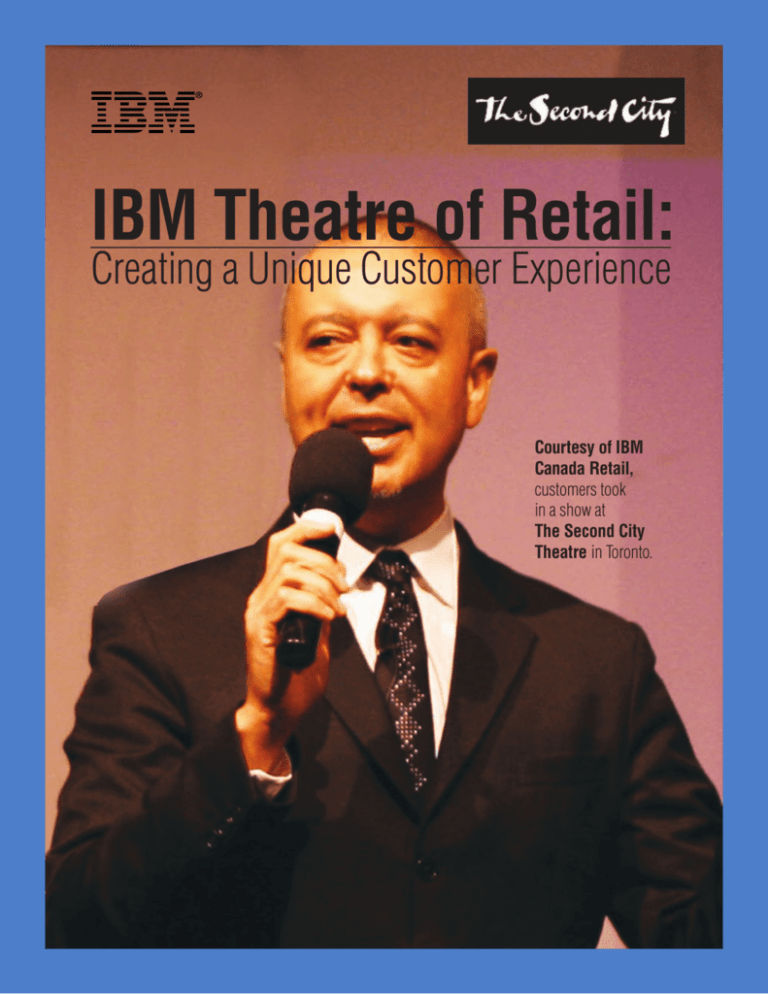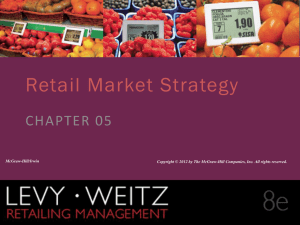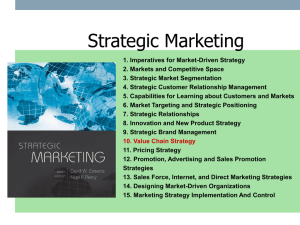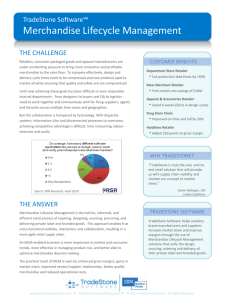IBM Theatre of Retail:
advertisement

IBM Theatre of Retail: Creating a Unique Customer Experience Courtesy of IBM Canada Retail, customers took in a show at The Second City Theatre in Toronto. IBM Theatre of Retail: Creating a Unique Customer Experience The lights dimmed. A hush fell over the audience. From stage left, an affable host bounded to centre stage as the bass line swelled. Applause erupted. topics – punctuating the chat fest with humorous asides. The audience of retail movers and shakers also had a role to play: they listened, laughed, asked questions, and reacted to surveys in real-time using a TurningPoint interactive device. SYNOPSIS: The setting: The morning line-up: The participants: Second City Theatre, Toronto Hosted by IBM Canada Retail Marketing. I Susan Confort, Worldwide Director of Marketing, IBM Retail The backdrop: And like any good theatrical production, there were some surprises along the way. A taping of Regis and Kelly? A night at the Royal Alex? Not exactly. Courtesy of IBM Canada Retail, customers took in a show at The Second City Theatre in Toronto. The name on the marquee? IBM Theatre of Retail: Creating a Unique Customer Experience. Throughout the morning, it was clear that IBM not only understands the customer experience, they are capable of creating one. So what exactly does the Theatre of Retail look like? Well, it’s like dinner theatre – for breakfast. Lee Smart, like chat-show hosts everywhere, perched on a stool to guide four retail expert panelists through a wide range of I Chris Johnston, VP of Apparel, Wal-Mart Canada I Liz Evans, Director, Ted Rogers School of Retailing, Ryerson University I Hung LeHong, Vice President of Research, Gartner Retail Industry Team I The audience: An enthusiastic mix of IT management, sales & marketing, operations management and C-level executives The retail industry is about the experience it provides to its consumers – fashion and colour, sounds and scents, satisfied clientele. Theatre. Today’s retailers are on the lookout for ways to create a customer experience that is distinct to their brand. That’s why the 2008 Retail showcase does not just talk about the customer experience, it creates one. I Customers heard respected industry figures share their ideas on innovative business models and best-in-class customer experience thought leadership I Participants enjoyed demos of state of the art technology specifically focused on the customer experience, with kiosks, personal shopping devices, store integration software and business process re-engineering The main event: The breakfast theatre session was divided into three broad topics: customer loyalty, improving the customer experience, and the barriers to a compelling customer experience. Scene #1: Customer Loyalty Host Lee Smart started by posing this question to the audience: Most of my customers are: I antagonistic I indifferent I engaged I fans Within seconds, interactive TurningPoint devices across the theatre were busily engaged. Minutes later, the results were in and a chart appeared onscreen. And the survey showed: According to the survey, 48 percent of customers are either indifferent or antagonistic, a startling finding that got the panel talking. UNDERSTANDING ANTAGONISM “We’re doing something wrong when almost 20 percent of customers are not happy,” said Wal-Mart’s Chris Johnston. The panel agreed that antagonists are the most dangerous consumers. People share bad news much more quickly than good news. However, the factors that create antagonism or support might be outside of the control of retailers. In today’s social media environment, opinions spread in a viral fashion. Although loyalty factors can be out of the retailer’s control, retailers need to understand how to influence the ‘buzz’ around their store. So the question for retailers is: How can we influence perceptions to create brand advocates? According to Gartner’s Hung LeHong, it takes more than just putting a corporate profile on Facebook. The company’s Web presence should also involve providing access to helpful tools and interactive features. Ryerson’s Liz Evans pointed out that indifferent customers are dangerous too, because there is an inherent dissatisfaction in their attitude, while Chris noted that the work and effort poured into converting antagonists will filter across the rest of the consumer groups, even the fans. CREATING FANS Pointing out that the survey showed that 20 percent of customers are fans, the panel noted that brand is paramount. Look at the loyalty Apple generates. On the other hand, a store focused on replenishment (convenience store) or a transaction (Money Mart) has limited potential to inspire fan behaviour. Although more fans are derived from brand than customer service, the key for winning fans is to create expectations and then consistently meet and exceed them. “Caring and empathy is part of our challenge,” Chris said. “Take the time to understand, so that the customer feels you relate to them, understand their needs and their values – and then react accordingly.” “In order to meet customer expectations, you have to know what they want,” IBM’s Susan Confort noted. “We need to tailor it to them and personalize it. How? According to Hung, customer service is about the sales people on the floor. Your brand is represented by your people. For grocers, product availability, convenience and freshness drives loyalty, according to an IBM survey six month ago. The economy also affects advocacy behaviour. In dire times, loyalty can change very quickly. Price can influence customers to switch to discount stores. In an abrupt shift to the theatre of the absurd, discussion was halted by an unexpected visit from self-proclaimed ‘retail guru’ Dr. Dash Walmsley, author of Mad Dash: 20 Tips to Making a Run for Success. To the strains of “ANY WAY YOU WANT IT,” Dr. Walmsley bounded to the stage. Calling himself an ‘experi-expert’ (someone who specializes in the customer experience), Dash proclaimed, “I am no egghead. I cut my chops in the stores and on the floors, observing, learning, eating, sleeping and dreaming the customer experience.” Laughter – but not much learning – ensued. Scene #2: Improving the Customer Experience Lee Smart asked the audience to answer the following question using their TurningPoint devices: As a consumer, the most important driver of the customer experience is: I Well-trained/attentive staff I Merchandise (breadth of selection/in stock) I Store layout/appearance I Loyalty program/tailored offers I Multi-channel presence (shop the way you want) Within minutes, a bar chart appeared on the onstage screen. And the survey showed: THE IMPORTANCE OF MERCHANDISE According to a decisive majority of respondents, merchandise selection and availability is the most important part of the customer experience. This stirred some discussion amongst the panelists. Chris wasn’t surprised by the results. “At the end of the day, if they don’t get merchandise right, nothing else matters. With the right insights, you’ll create the right products.” Hung agreed merchandise is crucial. “Gartner surveys show that in-stock and easy to find merchandise are the most important considerations for customers, although that varies by retail segment. The product is the bottom line. That label is in your closet, and you’re either happy with that brand or not, and it’s a reminder of the retail experience.” Susan noted that the store experience can be fun, but merchandise is still vital. She said that IBM research shows that there certainly are segments, like grocery, where merchandise is most important. Fair price is also an important driver for those segments. MULTI-CHANNEL PRESENCE AND LOYALTY PROGRAMS Liz was surprised by the low score for multi-channel presence. “Often, the Internet shopping component precedes the in-store experience. Customers want to know if items are in stock before getting to the store.” Susan agreed. “Tech-savvy young people expect to be able to make purchases anytime, anywhere. And they won’t tolerate anything less.” And the merits of loyalty programs? The panelists agreed that successful loyalty programs are about cash discounts to customers, convenience, and quickly receiving benefits. DELIVERING OVERALL VALUE “Again, it’s all about customer expectations,” Hung noted. “At a gourmet grocery store, customers expect a certain experience. If you don’t deliver, you’ll disappoint. In the discount store, speed at the checkout and breadth of merchandise are key components of the value.” Remember, a fair price and good location precedes the customer experience. But price is not the ultimate driver of fan behaviour. What is required is creating the perception of overall value. That’s where consumers become brand advocates. If you achieve that, you’re satisfying customers across many other planes: merchandise, product quality, speed of service, breadth of selection, and price. Due to ‘contractual obligations’ Lee Smart once again welcomed Dr. Walmsley back to the stage. Bounding forward, Dash yelled, “Bring on the retail noise!” then claimed that turning customers into brand advocates was his ‘wheelhouse.’ The trick? “Give them candy of course! People love candy. You get more flies with honey than with vinegar. It’s like drugs, but cheap and legal.” Scene #3: Barriers and Enablers of Customer Experience The final question posed to the audience was: As a retailer, the greatest barrier to creating a compelling customer experience is: I Employee turnover I Outdated technology I Not understanding customer expectations I Other business priorities I Lack of a customer-centric focus Once again, the theatre audience entered their answers into the TurningPoint devices. And the results showed: CUSTOMER EXPECTATIONS Not understanding customer expectations eclipsed every other barrier except the need for a customer-centric focus. How did that play with the panelists? “First impression?” Chris asked. “If 46 percent of retailers don’t understand customer expectations, then there are real problems.” According to Liz, the breakdown occurs because retailers are not always clear on who their target customers are. “Trying to be all things to all people can lead to too much competition with other retailers and confusion about customer expectations. If you’re consumer-centric, you have a very clearly targeted core customer, so understanding their expectations is a lot easier.” According to Hung, the local component is a key factor in understanding and meeting customer expectations. Large, centralized retailers can lose the local capability to meet sizing and pricing needs. “Segment your customer base, and then operationalize it by treating stores differently according to those needs. Ideally, a local store manager should have input on local preferences. Then, if it works well locally, distribute that idea across all the stores.” THE ROLE OF TECHNOLOGY Technology will continue to increase in importance. According to Susan, for younger consumers who have never lived without the Internet or cell phones, “technology is always there, and it always works.” Hung agreed that young people look for simplicity in use, as exemplified by the iPod. Therefore, technology needs to be focused on providing simplicity and functionality while hiding complexity. Chris pointed out that technology also supports retailers in executing their strategy. “If you’re customer-centric, you understand their expectations even at the local level, such as knowing which sizes to carry,” Hung said. “You know your market and who the core customer is.” And knowing the customer is what customer satisfaction is all about. As the panelists were applauded for their contribution, Dash bounded back onstage to the pounding rhythms of “The Final Countdown.” He recommended that retailers build mazes and puzzles in the store, suggesting that consumers will feel enabled when they overcome the barriers. “They will brag to their friends, and you will get brand advocates!” He concluded in noble fashion. “We are our own greatest barrier, and we are our greatest enablers. Lead through innovation, hypnosis, candies and mazes. You are the retailers, you are the IT people, and you have the power and knowledge. And with great power comes great responsibility.” Scene #4: TotalStore Showcase At the end of the final segment, attendees were asked to submit questions for the panel to address during the Q&A session. This was followed by an interactive TotalStore Showcase and networking session. The showcase provided a view of the state-of-the-art technology that enables retailers to differentiate themselves as leaders in the customer experience – with kiosks, personal shopping devices, store integration software and business process reengineering. Demos were staffed by the IBM TotalStore field team and included: I 3D Digital Media/ Second Life Plasma Display I Kiosk / Expert Advisor I Store Dashboards I Multi-Channel Retail (WebSphere) I Everywhere Interactive Display I Personal Shopping Assistant Mobile POS Scene #5: Question & Answer Session Q: Why have so many well-known brand-name retailers disappeared or lost their focus? Q: What ways are there to get to know your customers when you don’t have the budget to do that? A: They become diluted, which is dangerous. In economic boom times, it is possible to have growth without clarity on strategy. When times are good, how do you know when to change or take a risk? Rather than reacting, it’s important to be anticipatory. A: Market basket analysis, for example in a grocery store, lets you know what your customers are buying so you can stock the shelves accordingly. Also, have your staff talk to the customers on the floor. Build a culture of caring and listening, and then respond to concerns. Q: If we work to achieve true customer-centric focus, would we still need a traditional loyalty program? Q: How can retailers move into the next generation of analytics? How do we get this information into the hands of the right decision makers? A: Loyalty rewards the customer for the openness of their dialogue with you and keeps you focused on what matters. Loyalty programs can generate important data on your customer. A: Customer information needs to be endemic to operations. Get it out of marketing and into store operations and merchandising. EPILOGUE: CONCLUSION IBM can help you implement innovative strategies to differentiate your brand, reduce costs and work more efficiently by collaborating with suppliers and partners. For more information, contact your IBM representative or visit: www.ibm.com/retail/ca








